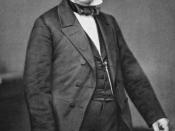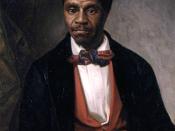The Presidency of James Buchanan: The Deepening Sectional Crisis
The Dred Scott Case
On March 6, 1857, two days after the inauguration, the Supreme Court rendered a decision in the long-pending case of Dred Scott v. Sanford. This case tested the constitutionality of laws regulating the status of slavery in the territories. Dred Scott, born a slave in Virginia about 1800, had been taken to St. Louis in 1830 and sold to an army surgeon, who took him first to Illinois, a free state, and then to the Wisconsin (later Minnesota) territory, where slavery had been forbidden by the Missouri Compromise, and finally returned him to St. Louis in 1838. After his master's death in 1843 Scott, who had become the property of one of the surgeon's lawyers apparently tried to buy his freedom. In 1846, with help from white abolitionist friends, he brought suit in Missouri courts claiming that his past residence in Illionis (a free state) and Wisconsin (a free territory) had made him free.
A jury decided in his favour, reaffirming the widespread notion that 'once free, forever free.' However, the state supreme court ruled against him, arguing that a slave state did not have to honour freedom granted to slaves by free states. The case finally found its way to the federal Supreme Court and the country awaited its opinion on the issue of whether freedom once granted could be lost by returning to a slave state.
The Supreme Court was divided with seven of the eight justices filing a separate opinion. However, a majority agreed with two principles enunciated by Chief Justice Taney (handout source).
- First, Dred Scott was not a 'US citizen' and hence was not entitled to sue in a federal court. In support of this assertion, Taney argued that...


